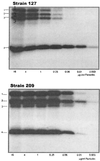All detectable high-molecular-mass penicillin-binding proteins are modified in a high-level beta-lactam-resistant clinical isolate of Streptococcus mitis
- PMID: 11408226
- PMCID: PMC90603
- DOI: 10.1128/AAC.45.7.2075-2081.2001
All detectable high-molecular-mass penicillin-binding proteins are modified in a high-level beta-lactam-resistant clinical isolate of Streptococcus mitis
Abstract
All detectable high-molecular-mass penicillin-binding proteins (HMM PBPs) are altered in a clinical isolate of Streptococcus mitis for which the beta-lactam MICs are increased from those previously reported in our region (cefotaxime MIC, 64 microg/ml). These proteins were hardly detected at concentrations that saturate all PBPs in clinical isolates and showed, after densitometric analysis, 50-fold-lower radiotracer binding. Resistance was related to mosaic structure in all HMM PBP-coding genes, where critical region replacement was complemented not only by substitutions already reported for the closely related Streptococcus pneumoniae but also by other specific replacements that are presumably close to the active-site serine. Mosaic structure was also presumed in a pbp1a-sensitive strain used for comparison, confirming that these structures do not unambiguously imply, by themselves, detectable critical changes in the kinetic properties of these proteins.
Figures


References
-
- Ausubel F, Brent R, Kingston R, Moore D, Seidman J, Smith J, Struhl J, editors. Current protocols in molecular biology. New York, N.Y: Greene Publishing Associates and Wiley Interscience; 1990.
-
- Avada A, van der Auwera P, Meunier F, Daneau D, Klastersky J. Streptococcal and enterococcal bacteremia in patients with cancer. Clin Infect Dis. 1992;15:33–48. - PubMed
-
- Bochud P Y, Engiman P, Calandra T, van Melle G, Saghafi L, Francioli P. Bacteremia due to viridans streptococci in neutropenic patients with cancer: clinical spectrum and risk factors. Clin Infect Dis. 1994;18:25–31. - PubMed
-
- Bouvet A, Durand A, Devine C, Etienne J, Leport C. In vitro susceptibility to antibiotics of 200 strains of streptococci and enterococci isolated during infective endocarditis. In: Totolian A, editor. Pathogenic streptococci: present and future. St. Petersburg, Russia: Lancer Publications; 1994. pp. 72–73.
-
- Carratala J, Alcaide F, Fernandez-Sevilla A, Corbella X, Liñares J, Gudiol F. Bacteremia due to viridans streptococci that are highly resistant to penicillin: increase among neutropenic patients with cancer. Clin Infect Dis. 1995;20:1169–1173. - PubMed
Publication types
MeSH terms
Substances
LinkOut - more resources
Full Text Sources
Molecular Biology Databases
Research Materials
Miscellaneous

